During the course of the CNDR excavations samples were routinely taken for pollen where deposits were judged to have good potential for its survival. The analysis of this pollen will hopefully enable the reconstruction of the vegetational history of the landscape at large and, more specifically, in close proximity to the sites where it was retrieved. The most promising conditions for pollen preservation were encountered within the palaeochannel at Stainton West, although potentially informative samples were also retrieved from an Iron Age ditch at Parcel 36, from the Vallum ditch associated with Hadrian’s Wall and a ditch pre-dating the construction of the Wall and Vallum. When these sequences are ‘stitched together’ it should be possible to understand how the landscape changed and evolved between at least the Early Mesolithic and the post-Roman periods. Humans will have played a major role in this and, amongst other things, this sequence should chart the maturation of the deciduous woodlands post-glaciation; the introduction of agriculture and the clearing of the landscape; the extent to which the construction of Hadrian’s Wall and associated Roman reorganisation had an effect; and whether there was a regeneration of woodland cover in the post-Roman period.



